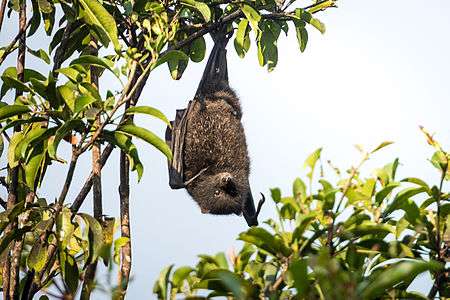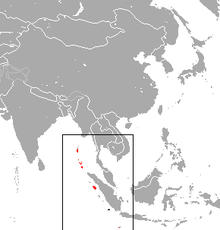Black-eared flying fox
| Black-eared flying fox | |
|---|---|
 | |
| Pteropus melanotus | |
| Scientific classification | |
| Kingdom: | Animalia |
| Phylum: | Chordata |
| Class: | Mammalia |
| Order: | Chiroptera |
| Family: | Pteropodidae |
| Genus: | Pteropus |
| Species: | P. melanotus |
| Binomial name | |
| Pteropus melanotus Blyth, 1863 | |
 | |
| Black-eared flying fox range (red — extant, black — extinct) | |
| Synonyms | |
|
Pteropus edulis | |
| Wikimedia Commons has media related to Pteropus melanotus. |
The black-eared flying fox (Pteropus melanotus), also known as Blyth's flying fox and Christmas Island flying fox, is a species of bat in the family Pteropodidae. It is found on Christmas Island (Australia), Andaman Islands (India), Nicobar Islands (India), and Sumatra (Indonesia).[1][2] The population on Christmas Island, which is critically endangered, is considered either a subspecies of Pteropus melanotus, or a distinct species, Pteropus natalis.[3]
Distribution and habitat
The black-eared flying fox is native to various island groups in the Indo-Pacific. These include the Andaman Islands, the Nicobar Islands, the Mentawai Islands and Christmas Island. It mostly roosts in large colonies in forests near the coast, especially in mangrove areas.[1]
Biology
The black-eared flying fox is more diurnal than most bats, emerging from its roosts before dusk and feeding on the fruits and flowers of at least twenty-six species of forest trees at least ten of which are introduced species. A single young is born annually.[1]
Status
The black-eared flying fox faces a number of threats. Destruction of its forest habitat reduces the availability of roosting sites and the animal is hunted by man for food. The crushed bones of this species are used in traditional medicine to relieve asthma symptoms. However, it has proved adaptable to changes in diet and now feeds on a number of introduced species of plant. The IUCN has rated this species as "Vulnerable".[1]
The population on Christmas Island is considered to be critically endangered,[1] and is listed (as Pteropus natalis) under the Australian EPBC Act.[4] C. R. Tidemann reported observing endangering behaviors on a visit to Christmas Island in 1984: "Three behavioural features make P. melanotus easy prey for hunters on Christmas Island even though firearms are prohibited: (1) a pronounced diurnal shift from the usually nocturnal habits of congenerics; (2) a tendency to feed close to the ground, particularly in the exotic shrub of Muntingia calabura; (3) a failure to respond in an appropriate manner to the approach of potential predators. (On Christmas Island P. melanotus has no predators other than man.)"[5] On Christmas Island, the bat is also predated by feral cats.[1]
References
- 1 2 3 4 5 6 Hutson, A.M., Kingston, T., James, D.,Lumsden, L., Molur, S. & Srinivasulu, C. 2008. Pteropus melanotus. In: IUCN 2010. IUCN Red List of Threatened Species. Version 2010.4. <www.iucnredlist.org>. Downloaded on 6 February 2011.
- ↑ Chiroptera Specialist Group 1996. Pteropus melanotus. 2006 IUCN Red List of Threatened Species. Archived 27 June 2014 at the Wayback Machine. Downloaded on 30 July 2007.
- ↑ John CZ Woinarski, Samantha Flakus, David J. James, Brendan Tiernan, Gemma J. Dale and Tanya Detto (2014) "An island-wide monitoring program demonstrates decline in reporting rate for the Christmas Island flying-fox, Pteropus melanotus natalis." Acta Chiropterologica, 16.1 (2014): 117-127.
- ↑ "Pteropus natalis — Christmas Island Flying-fox Species Profile and Threats Database, Australian government. Retrieved 24 November 2017.
- ↑ Tidemann, C. R. (June 1987). "Notes on the Flying-Fox, Pteropus melanotus (Chiroptera: Pteropodidae), on Christmas Island, Indian Ocean". Australian Mammalogy. Australian Mammal Society. 10 (2): 89.

